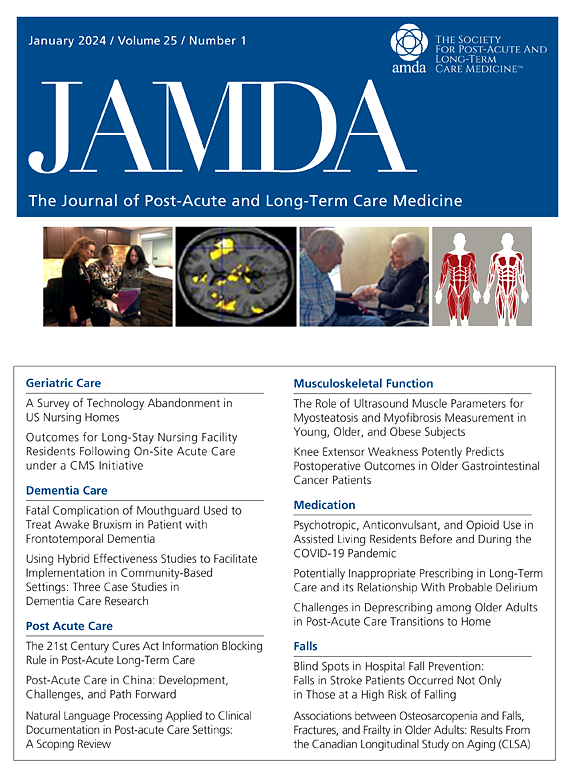虚弱、潜在健康状况和抗逆转录病毒治疗:预测HIV人群中熟练护理机构护理的成功。
IF 3.8
2区 医学
Q2 GERIATRICS & GERONTOLOGY
Journal of the American Medical Directors Association
Pub Date : 2025-06-24
DOI:10.1016/j.jamda.2025.105714
引用次数: 0
摘要
目的:艾滋病毒感染者(PWH)可能比那些有更多经济和社会支持的人更需要短期专业护理机构(SNF)的护理。因此,我们试图了解具有不同驱动条件、抗逆转录病毒治疗(ART)和社会人口因素的健康状况中的脆弱性与PWH短期SNF成功的关系。设计:回顾性队列研究。设置和参与者:短期SNF为PWH提供住宿。方法:在2014-2019年医保5%随机样本中确定住院病例(n = 1640)。零膨胀泊松回归估计了出院后1年内按年龄划分的家庭时间损失比率(结果:总体而言,716名(44%)SNF住院患者年龄在65岁以上,1154名(70%)为男性,764名(47%)为黑人,321名(20%)体弱,784名(48%)入院前ART≥80%。有3个健康概况:物质使用(SU);n = 467),心血管和肺(CV/PULM;n = 665),或多系统包括SU、CV、PULM和心理健康(MULTI;N = 508)。结论和意义:尽管健康状况可能有助于确定最有可能影响PWH健康的条件,但虚弱可能是识别那些需求最高、在SNF住宿后面临更大家庭时间损失风险的人的关键,这种影响因年龄而异。本文章由计算机程序翻译,如有差异,请以英文原文为准。
Frailty, Latent Health Profiles, and Antiretroviral Therapy: Predicting Success of Skilled Nursing Facility Care in an HIV Population
Objectives
People with HIV (PWH) likely need short-term skilled nursing facility (SNF) care more than people with greater financial and social support to remain home. Therefore, we sought to understand how frailty among health profiles with distinct driving conditions, antiretroviral therapy (ART), and sociodemographic factors relate to success of short-term SNF for PWH.
Design
Retrospective cohort study.
Setting and Participants
Short-term SNF stays for PWH.
Methods
Stays (n = 1640) were identified in a 2014–2019 Medicare 5% random sample. Zero-Inflated Poisson regression estimated rate ratios for home time lost in 1-year post-discharge by age (<65 vs 65+), health profiles established by latent profile analysis, frailty, and days covered by ART.
Results
Overall, 716 (44%) SNF stays were aged 65+, 1154 (70%) were male, 764 (47%) were Black, 321 (20%) were frail, and 784 (48%) had ART ≥80% of days before admission. There were 3 health profiles: substance use (SU; n = 467), cardiovascular and pulmonary (CV/PULM; n = 665), or multisystem including SU, CV, PULM, and mental health (MULTI; n = 508). Among stays aged <65, SU [rate ratio (95% confidence interval), 1.12 (1.09–1.15)] had more and MULTI [0.87 (0.85–0.89)] had fewer days lost than the CV/PULM group, but any ART carried higher rates of days lost compared with none. Among those aged 65+, SU [0.89 (0.85–0.92)] had fewer days lost, but MULTI [0.97 (0.94–1.00)] was similar in home time loss compared with the CV/PULM group. Having ART <80% of days [1.10 (1.06–1.13)], frailty [1.07 (1.03–1.11)], or pre-frailty [1.07 (1.04–1.10)] had higher rates of days lost.
Conclusions and Implications
Although health profiles may help identify conditions most likely impacting health of PWH, frailty may be key to identifying those having the highest needs and at risk for greater home time loss following SNF stays, with this impact varying by age.
求助全文
通过发布文献求助,成功后即可免费获取论文全文。
去求助
来源期刊
CiteScore
11.10
自引率
6.60%
发文量
472
审稿时长
44 days
期刊介绍:
JAMDA, the official journal of AMDA - The Society for Post-Acute and Long-Term Care Medicine, is a leading peer-reviewed publication that offers practical information and research geared towards healthcare professionals in the post-acute and long-term care fields. It is also a valuable resource for policy-makers, organizational leaders, educators, and advocates.
The journal provides essential information for various healthcare professionals such as medical directors, attending physicians, nurses, consultant pharmacists, geriatric psychiatrists, nurse practitioners, physician assistants, physical and occupational therapists, social workers, and others involved in providing, overseeing, and promoting quality

 求助内容:
求助内容: 应助结果提醒方式:
应助结果提醒方式:


